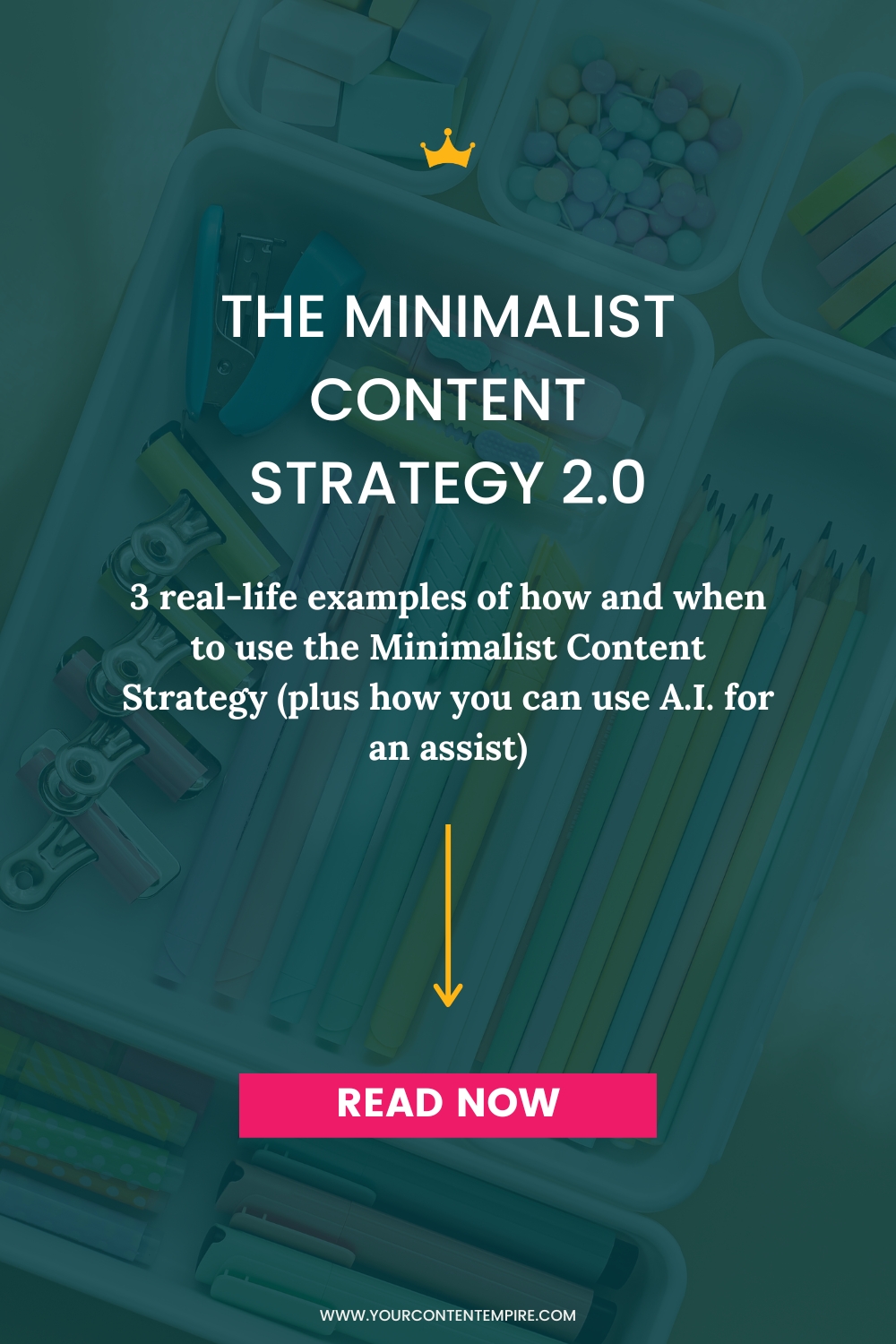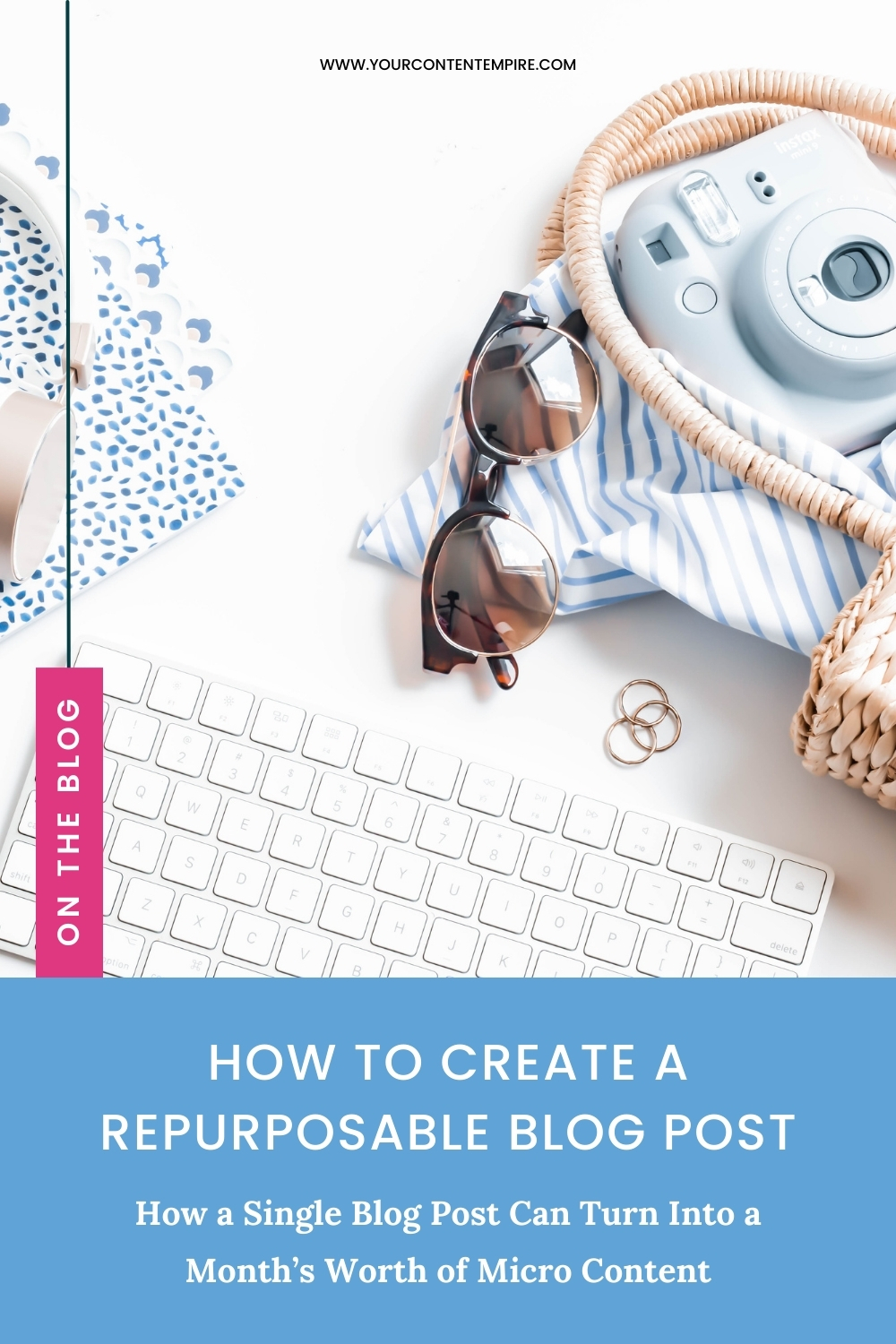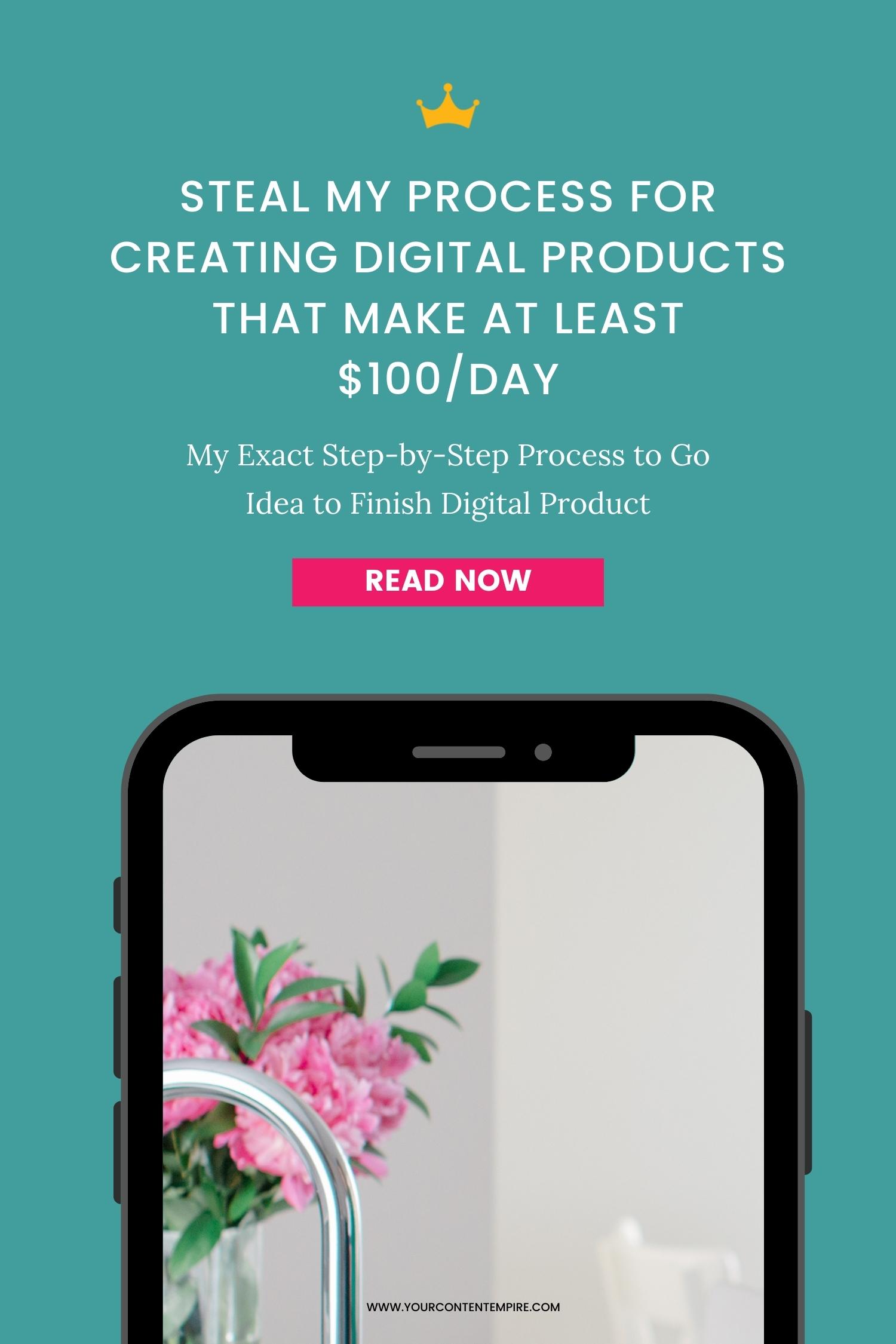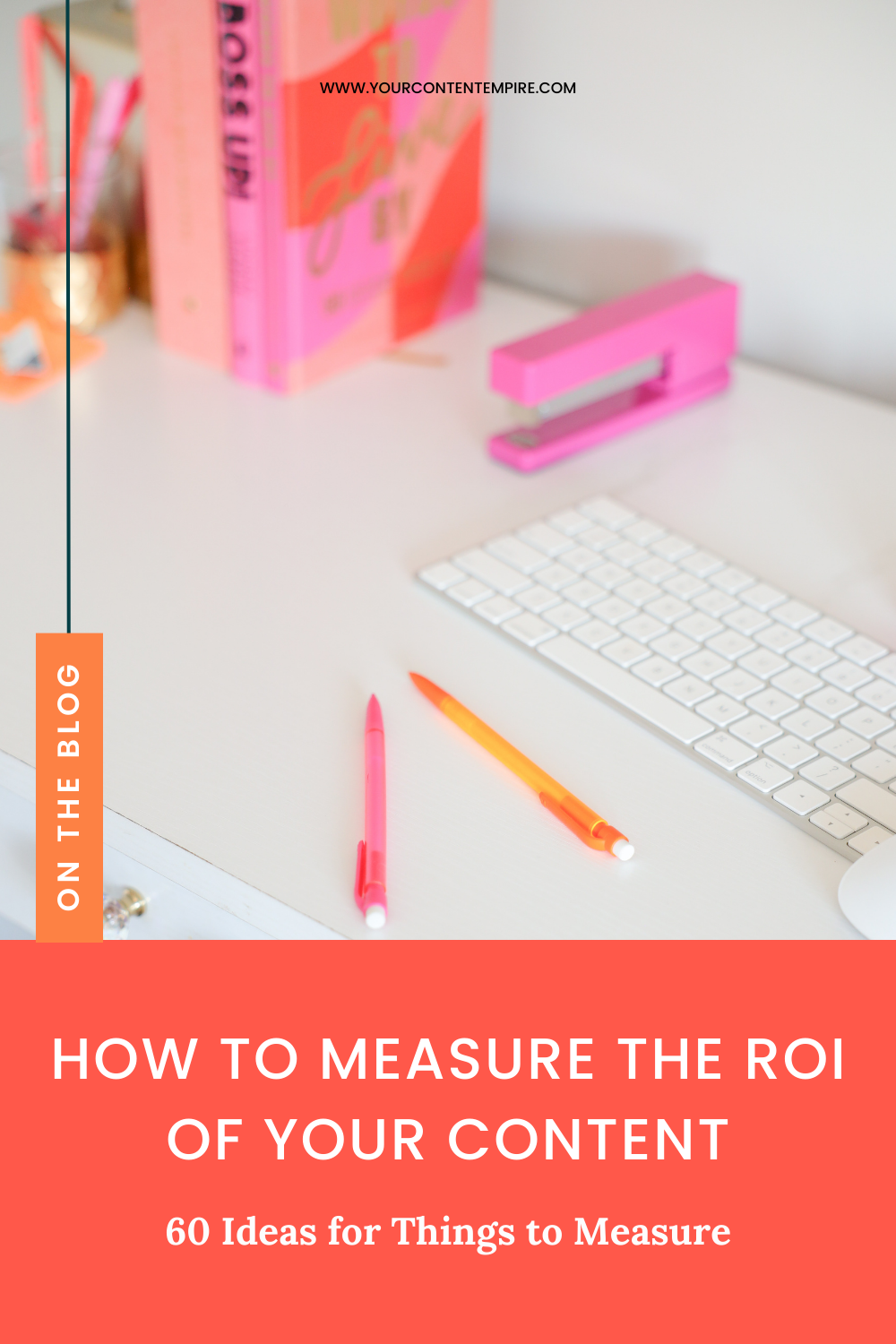It’s been a few years since I first introduced the Minimalist Content System (read the post here).
Here’s a quick recap:
And since then, I’ve been able to see it applied to dozens of businesses across multiple niches.
Here are a few of my favourite use cases of the system:
- As a pre-planned content break
- As a back-up plan
- As a content exit plan
How does AI fit in with the Minimalist Content Strategy?
AI has been a massive development since the Minimalist Content Strategy was originally conceived, and so one of the questions I get asked most now is what role does AI play in the creation of your capsule content.
And while it shouldn’t vary a ton from how you’re already using AI for creating your non-minimalist content system content, there are a few rules I think are helpful:
1 – Remember you’re going for quality over quantity—meaning that you’ll have the time to create really high-quality pieces you’ll share over and over again than you would if you had to create something new every single week.
2 – It’s pretty easy to spot something that’s been AI generated—unless you use AI as a junior copywriter to help you get a first draft that you then heavily rework and make your own. So make it your own—it’s worth it in order to stand out from the sea of samesy content that’s flooding ALL the channels.
3 – Give it source material to work with. This is one of my biggest tips on how to use AI while still making it sound like you and showcasing your unique processes. I like to feed AI raw material—whether that’s a video to base it off, a very detailed outline or a transcript from a content interview.
So AI can play as little or as lot of a role as you want it to. You can use it to create pieces to fill gaps you might be missing for your collections. Or if you’re starting from scratch to help generate the first drafts of the content. I wouldn’t say AI is going to save you a ton of time if used properly but it’s often easier to edit something than it is to start with a blank page.
Use Case #1 – A Content Breather
The first use case (that I’ve used for myself, might I add) is to use the Minimalist Content System as a way of taking a break either from your business entirely or content—all without going radio silent and seeing a major interruption in evergreen sales.
Some reasons to use the Minimalist Content System this way:
- You’re going on maternity or sick leave (and don’t want to lose all the momentum you’ve worked hard to build)
- You’re working on a BIG project that’s going to require your time, focus and energy (like writing a book, creating a new offer) and this means you won’t have any time left over for ongoing content creation
- You want to take a vacation or the kids are out of school so you can reshare your old posts (strategically using the Minimalist Content Strategy) and still see sales while you’re off living life
See It Action:
When my client, Clara, had her first baby(!!), she was faced with a predicament that a lot of online business owners face: if they’re not working, they’re not bringing in money.
And yes, an evergreen funnel can do a lot of the selling for incoming community members—but what does that mean for the rest of the platforms? Should you just batch a year of posts so it just seems like you’re there?
In this example, we used the minimalist content system to pull together content campaigns from her previous posts. We went through the internal and external channels and how each would work while she was away from the business.
She was able to take an entire year off while still making consistent sales. Not bad for putting her paid list growth on pause while she was away and just focusing on her existing audience and those who joined from social platforms!
Your Implementation Plan:
- Figure out how long you’re going to be off (give yourself a buffer to ease back in when you’re back too!)
- Decide how many content campaigns you can fit into that time period (usually 4 weeks nurture content then 1-2 weeks sales invitations)
- Pull from your existing content
- Schedule everything in advance or build out into automations
Want help getting a head start on your capsule content collection?
Want some help getting your offer(s) ready for your minimalist content system?
This free on-demand workshop will help you choose your offers, prepare your sales messaging and invitation emails. Sign up here ↓
Use Case #2 – Back-Up Plan
The second use case is for the situations that we usually don’t like to think about so much, which is when you’re forced (with little to no notice) to take a break from your business.
Some reasons to use the Minimalist Content System this way:
- You get sick or someone in your immediate family gets sick and you’re out of commission for a few weeks
- You need a mental health week (or two) but you feel pressured to show up anyways for the sake of the momentum you’ve built
- Or something else unexpected happens and you have to step back
See It Action:
I worked with a past client, Diane, when she was offering a beta service on contingency planning—basically how to prepare your business for worst case scenarios. What would happen if you were suddenly unavailable? Who would know how to contact who and all that. She called it ‘What If’ planning.
So, after our work together, I had my ‘what if’ plan in place with the hope that I’d never have to actually use it but reassured it was there just in case.
Even though we never discussed it, I realized that I could do the same prep for my content too. So I have a few emergency content campaigns that can cover 3.5 months of content and emails with the press of a few buttons ready to go—just in case.
Your Implementation Plan:
- Choose at least 4 content bundles (blog posts, emails and social content) that could go out at anytime of year
- Compile all of your email content into an automation that your community can be added to if needed
- Compile all of your social content that can be bulk scheduled on your social channels if needed
- Write instructions on how to schedule them so that someone else can easily complete it if you’re not able to
Curious—and want to learn more about the Minimalist Content System?
Want some help getting your offer(s) ready for your minimalist content system?
This free on-demand workshop will help you choose your offers, prepare your sales messaging and invitation emails. Sign up here ↓
Use Case #3 – Content Exit Plan
The last (but definitely not least) use case is to use the Minimalist Content System as an exit plan. I’ve seen more people exit their business in the past year than ever before (see some of the reasons below). And the big question becomes—what to do with the original business and all of the content assets you’ve created? Especially, if finding a buyer for the business isn’t an option or hasn’t happened yet.
Some reasons to use the Minimalist Content System this way:
- You want to go all-in on a new business and don’t want the emotional tie of trying to maintain another at the same time
- You’re finished with your business and want to switch up what you’re doing either taking a sabbatical to figure out your next move, transitioning into a 9-to-5 or spend your time doing something else (some that I’ve heard are full-time writing, volunteering, leaning into stay-at-home mom life, or creating art)
- You’re burnt out from business and while you’re not sure you want to shut it down, you do know you need an extended break
See It Action:
The beauty of this strategy is that from the outside looking in, no one needs to know you’re even using it. And so, for that reason, this next example is completely anonymous.
We’ve been producing a client’s content for years through the agency and last year, she’d started a completely new brand and wanted to walk away from the very successful business she’d built.
Instead, we turned her VAST library of content into 7 automated content campaigns which culminated in sales invitations for her evergreen offers. She actually increased sales by 32.74% over the previous year. Which became a good financial buffer when building up a new business went slower than expected.
Your Implementation Plan:
- Decide what evergreen offers you want to sell on an ongoing basis
- Plan out content campaigns that lead to sales invitations (goal: at least 12 months covered)
- Prepare content campaigns
- Build out automations
- Schedule social media posts
- Recommendation: This strategy works very well when paired with an evergreen sales funnel for incoming email subscribers and then transitioning them to the automated campaigns in your Minimalist Content System
This is a simplified action plan but includes the high-level milestones as guideposts when putting together your own Minimalist Content System.
Start Here—Get Your Offer Ready for a Capsule Content Collection
This free on-demand workshop will help you choose your offers, prepare your sales messaging and invitation emails. Sign up here ↓







